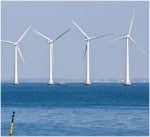A novel concept from MIT engineers could deliver abundant wind power to national grids by enabling offshore floating wind turbines to store energy using giant cement spheres on the sea floor.
The MIT team say that with proper storage capacity, offshore wind power is now capable of delivering upwards of 20 percent of U.S. electricity demand, and believe their plan for underwater ‘wind power, without wind’ is feasible.
The concept works on the principle of hydrostatic pressure. Each sphere would be around 30-metres in diameter and hollow to allow water to flow in and out. With walls three-metres thick, the sphere would be so heavy it would also double as an anchor for the turbine floating above. Whenever the wind turbine produced more energy than needed, the excess power would pump seawater out of the sphere, before letting it flow back in through a turbine to generate electricity.
A single 25-metre sphere, anchoring a wind turbine at a depth of 400 metres could store up to six megawatt-hours of power. Multiplied a thousand times, the MIT team says, and you have the equivalent energy output of a coal or nuclear power plant for several hours, all the on-demand electricity needed to shore up intermittency issues related to wind power.
Depending on the depth of the each sphere and its size, the researchers believe the system could provide base-load utility-scale renewable energy from floating wind farm platforms, weather permitting. They have calculated the cost of building and placing a single sphere on the sea bed at about $12 million, but say as manufacturing practices improve, costs would eventually reach six cents per kilowatt hour – a price on par with fossil fuels.
So far the design hasn’t gone beyond a 75-centimetre working prototype, with plans to scale up to a 10-metre working model, but MIT has filed a patent on the concept should funding become available in the future.
Source/image source












































